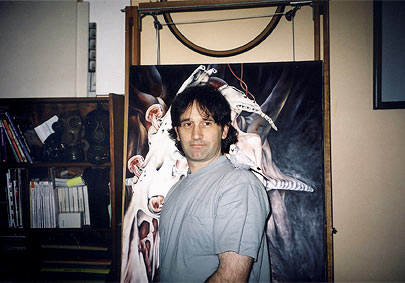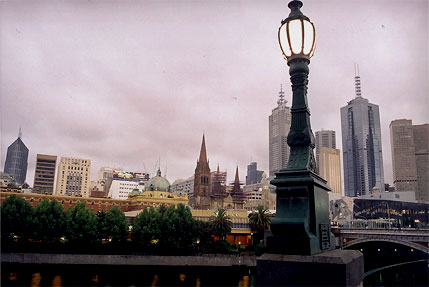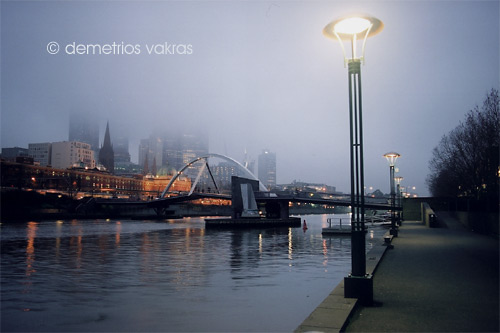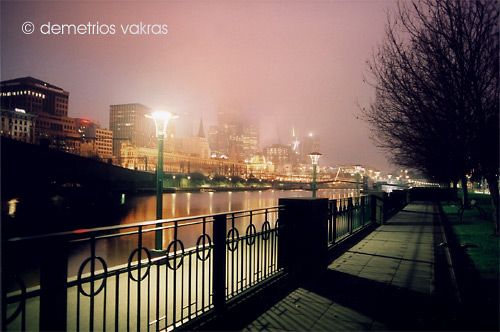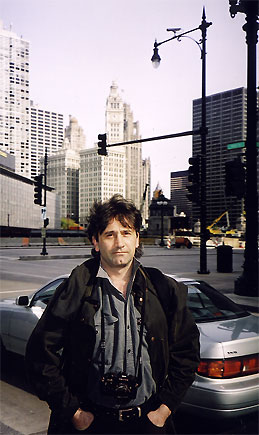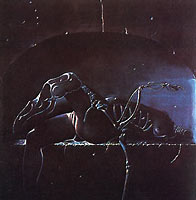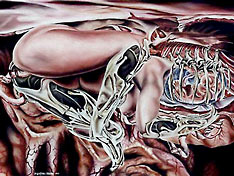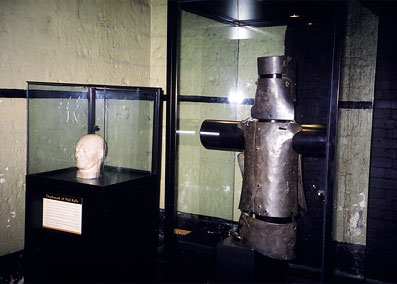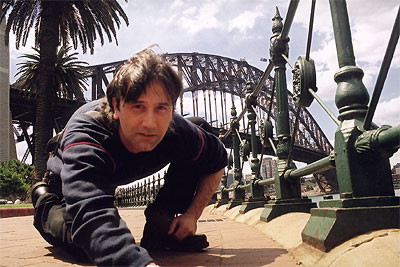|
|
(... the little feathery guy was euthanased by a vet on 28 June 2006. He was suffering from gout - which for budgies is indicative of kidney failure. I have since found that his gout was treatable, however the vet insisted the bird only had one option. It is so quiet now.) |
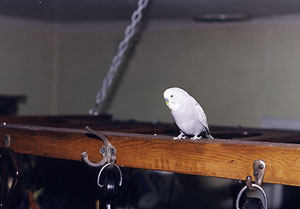 the Hubster .... master of the ambush, the Hubster's idea of a bird bath.... 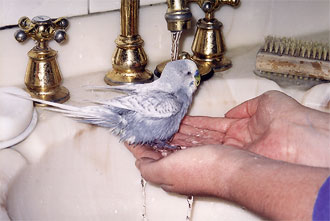 |
Demetrios Vakras was born in Melbourne, Australia, in 1962. He has been painting with oil paints since 1977 and has never wavered from his elucidation of the bizarre, fantastic and surreal. He is self-taught and his earliest influence was the work of the surrealists: Dali, Magritte, Bellmer.
Vakras' current imagery of dismembered human forms recombined with animal skulls, jaw and pelvic bones, stem from his earlier so-called apocalypse series. In these earlier paintings the individual is imprisoned by, and part of, the machinery purpose-created to ease existence, machinery which for the term of an individual's existence requires constant maintenance against its dissolution by entropy.
In his current works the philosophical line has been largely abandoned. Although the pictorial elements remain the same they generally serve no purpose other than the fantastic. Forms metamorphose into unlikely recombinations. He sees veristic illusionist fantastic art as an ongoing theme in western art which includes within its historical repertoire Hieronymous Bosch, Grunewald, Blake, Fuseli, the symbolists, the surrealists, the artists of the Vienna School of Fantastic Realism,...etc.
Illusionist fantastic art predates surrealism. Surrealism is now part of the inheritance of fantastic art to come.
Melbourne was founded in 1835.
When the separate colonies of Australia united to became a federation forming the nation of Australia in 1901 Melbourne became its first national capital until 1927.
Canberra has been Australia's capital since 1927.
After the gold rush in the 1850s Melbourne became the largest city in Australia, a position it retained until it was overtaken by Sydney over a century later.
It is now Australia's second largest city with a population of 3.5 million.
(Melbourne photographed from the Yarra River).
Melbourne just before sunrise, in fog, August 2004
Melbourne a half hour before sunrise, in fog, August 2004ARTIST STATEMENT:
Although my early art was influenced by the surrealists it has continued to diverge from traditional surrealist principles. I reject the idea that random accidents make for good art (essentially Lautreamont's famed encounter of an umbrella with a sewing machine on an operating table). Unless these accidents are refined and articulated they remain accidents. This therefore takes my work out of the surrealist ambit. My art is closer to what is called fantastic art rather than surrealist. I suspect it would be best described as being closer to a form of 19th century symbolism which however has learnt the lessons of 20th century surrealism - a kind of "surrealised symbolism".
ADDITIONAL INFORMATION:
[ pdf: PDF Flyer on the art of Vakras
pdf in the Greek language: PDF Flyer on the art of Vakras ]
"Man (or woman) it's cold!!"
Demetrios grimacing on a late Chicago morning as the temperature hovers at around 3 degrees Celcius (or 38 F), with the wind making it all that much colder, 27 October 2002.
It only gets this cold in Melbourne sometimes, in the middle of winter, in the dead of night!!
But what would the point be of visting anywhere if it was the same as home!
(Demetrios was in Chicago to attend the opening of Echo Gallery's Halloween Exhibition 2002 in which some of his works were featured, along with works by Dan Ouellette, and many others.)
POLEMICS:
Surrealism in Australia tends to be disparaged. Criticism generally dismisses it with contempt. Take as an example this excerpt from a review in the Sydney Morning Herald 23/10/1993 by Age art critic Robert Nelson: "It must be the year of the surrealist Phoenix...I hope it does not sow a generation of unconscious painters."
I have never known of the unconscious to paint....! This was supposed to be a review on a monograph on Australian surrealist artist James Gleeson...instead it was a personal attack on the artist because, as the critic made obvious, he despises the genre.
...This predisposition to stilted criticism is not limited to any one "art reviewer". Other critiques demonstrate just as emphatically the shortcomings of the intellect behind the critique. For instance the reviews by the Australian's art critic, Robert Rooney (again on Gleeson's work*), made constant references to science fiction:
" while some of his images might seem to be Alien-like, he is not an illustrator in the science-fiction or related genres." (W.E. Aust. 24-25/9/1994)
... which sounds much like what he had written 3 years earlier:
"I heard them dismissed as being too much like science fiction illustration"(W.E.Aust. 26-27/10/1991).
Even in reviewing another surrealist artist's work, in this instance the work of EM Christensen, Rooney wrote: " the science fiction illustrations her paintings sometimes resemble." .(W.E.Aust. 19-20/8/1989)... Either Rooney attends such exhibitions (in 1989, 1991, 1994) with (coincidentally) the same people or those that he "heard" dismissing the art as science fiction are an invention. I have been to several Gleeson exhibitions and never heard any such comments.
It is worth remarking that:
A/ Gleeson's repertoire was already established with paintings like Citadel (1945) and Agony in the Garden 1 (1947) - which makes a 5 and then 7 year old Giger (born 1940) an unlikely influence!
B/ Both Rooney (a practicing "artist") and Gleeson were represented by the Melbourne gallery Pinacotheca... One suspects Rooney felt compelled to review the works by another artist practising a genre he was obviously largely ignorant of, so that he could promote the profile of the gallery which represented him....
By describing as "science fiction" or alluding to its appearance as "science fiction" any art of the imagination is reduced to low brow populist illustration - ephemera. I suspect the fear is that great art is elitist - that is, very few have the talent to produce it. Most post-Duchamp garbage is "egalitarian" - anyone can be an artist by labelling anything art and simply calling themselves an "artist". "Art" then is expression unencumbered by technique, ability, or even the need to say anything at all..... It is all about pretensions to grandeur.
*note: James Gleeson is pretty much the only artist of the imagination whose work is reviewed by the mainstream Australian media and is Australia's only "successful" artist of the genre. Hence reviews on him are plentiful.
An aspect of art appraisal that fascinates me is the categorisation of any work by an unfamiliar artist as being similar to, influenced by, or in imitation of, the style of another. In days past the only surrealist artist popularly known in Australia was Dali. Consequently my work was "like Dali's"! Now I'm apparently just like Giger*!
(* mispronounced by anglophones as "Geiger"!)
And this is not limited to the general public's perception of art; Robert Hughes (former art critic for Time magazine), in his book titled The Art of Australia, 1966, dismisses the work of James Gleeson (again) as nothing more than the work of a Dali imitator (though there is some truth in Hughes' claim).
Many artists have had an influence on my own work, from Dalì and Magritte to Bellmer. So too have the works of lesser known artists such as one painting by Pavel Tchelitchev, Cache de cache (hide and seek) 1940-42, and a painting by another artist, Mitsuyoshi Haruguchi (Transmigration of soulsbelow left), which I saw reproduced in the book 20th Century Masters of Erotic Art, Bradley Smith isbn 0-517-542366. The influence of Haruguchi's painting can bee seen in my painting Visceral symbiosis (below right).
Mitsuyoshi Haruguchi, Transmigration of souls, tempera on board. 1978When I added this image, many years ago now, there was no information availbable on this artist on the internet. He now has a website:
Haruguchi, art: http://haruguchi.jp/works_en
(http://haruguchi.jp/index_en)His website provides both a different title and year of creation for this painting: reincarnation - a bird, 1974. (Of course, it could be a different versioin). Haruguchi has an entire series of "reincarnations" of which I was not prevoiously aware (1 Jun, 2009).
Visceral symbiosis, oil, 1993
...AUSTRALIANA.........
This is the great tragedy of Australian art: it is the artists who pander to the national psyche... and illustrate national folklore and myths that are the ones acclaimed and celebrated. Art, like sports, must serve the national interest to succeed.... Essentially it is national propaganda art....like that of the Boyds et al, which is therefore celebrated.
....... As Jeffrey Makin, art critic of the Herald Sun recently wrote in his obituary on Arthur Boyd:
"Boyd, more than any other Australian painter peopled our outback with accessible motifs that helped form our national psyche and self image...he will be sorely missed." (Herald Sun 28 April 1999)
So "Australian" was Boyd that he lived in London....not Australia when he died...
This is, I suppose, symptomatic of a nation with no identity which, in endeavouring to create an identity, celebrates populist and mindnumbingly obvious ho-hum symbols.
My view is hardly unsupported:
"The late 1940s and on into the 1950s saw the perennial testing by Australian artists of themselves on the European [British] scene...Drysdale and Nolan (and subsequently Arthur Boyd) in particular were exhibiting their Australian imagery and achievement on the international stage and, for better or for worse, not without success. For others, not so stridently identifiable in their Australianness, this was not always the case."p. 219 A Story of Australian Painting. Mary Eagle & John Jones, Macmillan Australia.
Gleeson's work was never "Australian" enough...his paintings sell for around thirty thousand Australian dollars. The very "Australian" Boyd, however, sold his works for well over five HUNDRED thousand Australian dollars...Ironically Boyd's works are worthless internationally.
On 21 June 2000 the Prime Minister of Australia, John Howard, made a speech at an Australia Council opening. He quoted from a report which studied how to best promote the arts in Australia. The following is part of the transcript:
"...the report found [that] the great majority of Australians saw the Arts as an opportunity to express...what we think it is to be Australian, what the essence of Australianism is and the values that we hold as Australians. And that very strong identification between the Arts and our national identity is always something that I believe has resonated very strongly in the Australian community." (my italics)
The great tragedy is, that realising that they are merely Englishmen (& women) displaced , Australians have tended to try to create an identify separate from England. The landscape then becomes an obvious motif as a point of difference.
It is not coincidental therefore that artists such as Nolan, Boyd, Drysdale, are ethnic English, who went to their motherland at the conclusion of the second world war where they were celebrated as greats simply because their Australian landscape did not look English...and who upon their return were celebrated as greats in Australia on the basis of this recognition in England. Australia has always looked to the "superior" dictates of its ethnic motherland...
When given the choice, Australians voted to keep the Queen of England as their own head of state in the recent referendum of November 1999.
And if art is merely the vehicle for expressing myopic parochial and nationalistic visions then it is no different from the art of Stalinist Russia, Nazi Germany, or the state sponsored art of Saddam Husein's Iraq.
the photo, left, taken at the Old Melbourne Goal, is of the "death mask" of Ned Kelly with the armour worn by his brother Dan Kelly beside it. The Kelly brothers were members of a gang of bushrangers (outlaws). They made the armour depicted and had a shoot-out with police in the nineteenth century. Ned Kelly (wearing armour similar to Dan's) was captured alive and hung. It has become the stuff of legend... And 'Australian' artists (read: English), whose work is surprisingly taken seriously, have painted entire "Ned Kelly Series" of paintings. Somehow American depictions of the "wild west" are culturally passé, ... but the equally passé Ned Kelly theme is the stuff that makes for great art here! You'd be embarrassed to call your self Australian .. you would think?
In 2002 there were a number of Ned Kelly exhibitions in both Melbourne and Sydney; there was a film on Ned Kelly; and a novel which won an international writer's prize..... Oh dear.
At this stage however, it is worth pointing out that the current trends in Australian art are also dictated by art fashion. New York is now almost as influential as London once was. To be cultured is to be aware of the current art fashion trend. And so, like the Pokemon phenomenon amongst their children, the adult connoisseur, not to appear a moron amongst his/her peers, can name all the Pokemon characters.... metaphorically speaking. And the last thing you would want to do is discredit your well-earned reputation, by praising the work of an unknown artist.
It does, however, remain a prerequisite in Australian art that artists still somehow demonstrate their "Australianness", as the crisis in identity is not an issue yet resolved in this country.
Demetrios' photo-self portrait in Sydney 6 December 2002Sydney is Australia's largest city. Alas it is not a place in which art counts if you go by the kind of superficial art criticism that appears in that town's broadsheet the Sydney Morning Herald (SMH). Probably the worst critic I have come across in recent times is Peter Hill, who writes for that paper. Unfortunately for Sydney he is also a lecturer at the University of NSW College of Fine Arts. As an example of the views he propounds is the following:
"A list of internationally renowned artists who grew up in the provinces could read like this: ...Leonardo, Duchamp, Dali....El Greco... Piccinini..." (Metro section, SMH, Friday 4 April 2003)Piccinini? Piccinini is an "artist" who Peter Hill is aware does not create her own work. Although she claims her works to be a "collaboration" the finished product is attributed as being her sole creation; no attribution is made to any other artist other than her. Works attributed to her are created by others best able to fulfil her brief, who create on her behalf, what she herself cannot. Thus, it is up to the "collaborator"(sic) to actually make her ideas work, someone else's creative ability to make them a reality.
(...Just imagine the kind of damage Peter Hill's students will inflict on the Sydney art scene in the future.)
It is worth noting that her husband, Peter Hennessey, was a board member of the Australia Council (refer: http://www.ozco.gov.au/newmediaarts/members.html ) a government body which gives grants to artists. In Piccinini we have the example of an "artist" who does not create what has been attributed to her, who Peter Hill celebrates as an equal to incontrovertibly important artists. One wonders whether Piccinini's success (she is, for example, to represent Australia at the Venice Biennale in 2003 ... ) is attributable to the contacts her husband made when he was responsible for the doling out of government funds ... a kind of sick symbiosis ... (why does Piccinini receive the accolades and publicity whilst the actual creators of the works attributed to her remain essentially unknown?). In Australia it is who you know, not what you know, or whether you have any ability that will influence whether you will succeed...
SYDNEY REDEEMED:
... Australia has a new art magazine published in Sydney and edited by John McDonald: Australian Art Review (its online presence can be found: www.artreview.com.au). A robust magazine it will irk as many in the art scene as it will please as it challenges many of the pretensions of the Australian sycophant... The cultural intelligentsia (and not just of this nation) inhabit a world in which they don't know much about art, but know what pretensions make them appear that they do... This magazine presents alternate analyses to those found in newspapers and other art journals in which reviews often sound, suspiciously, like the artist's own press-releases.
....CLIQUES AND SUCCESS....
The success Piccinini has achieved as an "artist" is the defining phenomenon of the Australian art scene in the formative years of the 21st century. Her success is a corollary of the incestuous uncritical sycophantic nature of the cultural intelligentsia of this country. Art 'critics' seem more intent in demonstrating their awareness of cultural fashion and scramble to outdo one another in the praise they lavish on an already critically acclaimed artist rather than provide any clear critical analysis of the artist in question. Uncritically, they pass off what seem to be Piccinini's press-releases as matters of fact. This is not criticism at all."...artist Patricia Piccinini, five times named by this publication as one of Australia's 50 most collectible artists, has achieved another career milestone with her selection as Australia's representative at the world's most prestigious art fair, the Venice Biennale."
So writes Michael Hutak in Australian Art Collector (ISSN 9 1328-9586) issue 24 April - June 2003, a magazine which features "Undiscovered artists" and "Australia's brightest new art stars". Hutak's article on Piccinini attributes "mixed media" sculptures Game boy Advanced 2002 & The young family 2002 to Piccinini. They were however not created by her. As Piccinini stated on Channel 9's Sunday Show 16/2/2003:
"I couldn't find a way to depict these new ideas in oil and so it meant I had no skills. And then I thought if I can't do anything, I can do everything if I work with other people, and that's when I started collaborating."
"Collaboration" has an altogether other meaning for Piccinini. The actual creator of these sculptures is Sam Jinks (Sunday, Channel 9 16/2/2003). Why does that make her the artist?
Piccinini is the "it" artist(sic). She has not only been featured in Australian Art Collector and Channel 9's Sunday Show, but also in Photofile (magazine) issue 68 April 2003 (ISSN 0811 0859) in an article by Alasdair Foster; Natalie King, Australian Art Monthly, March 2003, No 157 (ISSN 1033 4025); numerous articles by the SMH critic Peter Hill (e.g. 25-26/1/2003); Anne Loxley, SMH, 28/8/2002; Jane Faukner, Age, (newspaper) 27/11/2002; Gabriella Coslovich, Age, 25/11/2002,18/12/2002 AND 21/12/2002; Lara Travis, Age, 27/10/2001; Susan McCulloch-Uehlin Weekend Australian 27-28/10/2001..... and this list is certainly not exhaustive! Somehow whether deliberate, or because of their intellectual laziness, these critics behave something like co-conspirators in an artistic fraud...
And in the process Piccinini has achieved success without actually having either the skill to create anything and without having created anything at all ...!
In summary, the bankruptcy of the Australian arts intelligentsia is expressed thus by Juliana Engberg Artistic Director of ACCA (Australian Centre for Contemporary Art):
"Patricia embodies what we want in an artist." Sunday 16/2/2003. Now how can you top that?

